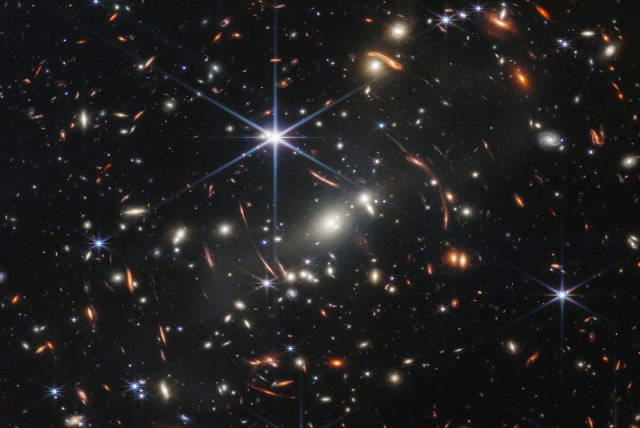Israeli astrophysicists may have solved the mystery of early massive galaxies

A new theoretical model made by Israeli astrophysicists reveals an excess of massive galaxies, in contrast to previously accepted theories.
The mystery of the formation of early massive galaxies in the universe has finally been solved by astrophysicists from the Hebrew University of Jerusalem (HU) who have published a new theoretical model that explains recent observations that used NASA's James Webb Space Telescope (JWST).
They said they revealed a surprising excess of massive galaxies in the universe – already in the first half billion years after the Big Bang – contrary to the commonly accepted theory.
The team published their findings in Monthly Notices of the Royal Astronomical Society under the title “Efficient formation of massive galaxies at cosmic dawn by feedback-free starbursts.”
Researchers discover excess of massive galaxies
The James Webb telescope was launched into space at the end of 2021 and started producing images of distant galaxies as early as last July. The researchers unexpectedly discovered an excess of massive galaxies in the early universe compared to the number of galaxies expected according to the common theory.
According to the researchers’ proposed model, the special conditions that prevailed in the primordial galaxies, of high density and low abundance of heavy elements, allowed the formation of stars with high efficiency without interference from other stars.
The research team from HU’s was led by Prof. Avishai Dekel with Dr. Kartick Sarkar, Prof. Yuval Birnboim, Dr. Nir Mandelker and Dr. Zhaozhou Li. The Racah Institute of Physics, located on the university’s Safra Campus (Givat Ram) campus, has some 90 faculty members who teach and carry out research in the fields of astrophysics, condensed matter physics, high energy physics, bio and non-linear physics, nuclear physics, and atomic, molecular and optical physics.
“Already in the first half-billion years, researchers identified galaxies that each contain about ten billion stars like our Sun,” Dekel explained. “This discovery surprised researchers who tried to identify plausible explanations for the puzzle, ranging from the possibility that the observational estimate of the number of stars in galaxies is exaggerated, to suggesting the need for critical changes in the standard cosmological model of the Big Bang.”
According to the prevailing theory of galaxy formation, gravity causes gas scattered in the universe to collapse into the centers of giant spherical clouds of dark matter, where it becomes luminous stars, like the Sun. But theory and observations until now have shown that the efficiency of star formation in galaxies is low, with only about 10% of the gas that falls into the clouds becoming stars.
The inefficiency is caused by remaining gas heating up or being blown out of galaxies under the influence of winds and supernova explosions from the stars that manage to form first. This contradicts recent JWST indications of vast amounts of stars created in a short time frame, he continued.
Is this the key to explaining super-massive black holes?
In this study, Dekel and his team proposed a process termed “feedback-free starburst” (FFB), which naturally explains the mystery. Under the unique conditions prevalent in early galaxies, gas efficiently turns into stars without being disrupted by feedback processes.
This idea is based on a time delay of more than a million years between the formation of massive stars and their subsequent explosions as supernovae.
Before the enrichment of the gas by heavy elements produced in stars, the researchers suggest star-forming clouds in the dense early universe had a density above a threshold that allowed the rapid collapse of the gas into stars within the “window of opportunity” of one million years. This process of high-efficiency star formation in the absence of feedback explains the observed excess of massive galaxies.
“The publication of this research marks an important step forward in our understanding of the formation of primordial massive galaxies in the universe and will no doubt spark further research and discovery,” Dekel concluded.
“The predictions of this model will be tested using the accumulating new observations from the Web Space Telescope, where it seems that some of these predictions are already confirmed. Important implications of the proposed FFB scenario will be investigated in future studies.
These include the efficient formation of seed black holes of a thousand solar masses in the centers of the FFB star-forming clusters, which are key to explaining the surprisingly supermassive black holes of a billion solar masses seen in centers of galaxies half a billion years later.”
Jerusalem Post Store
`; document.getElementById("linkPremium").innerHTML = cont; var divWithLink = document.getElementById("premium-link"); if (divWithLink !== null && divWithLink !== 'undefined') { divWithLink.style.border = "solid 1px #cb0f3e"; divWithLink.style.textAlign = "center"; divWithLink.style.marginBottom = "15px"; divWithLink.style.marginTop = "15px"; divWithLink.style.width = "100%"; divWithLink.style.backgroundColor = "#122952"; divWithLink.style.color = "#ffffff"; divWithLink.style.lineHeight = "1.5"; } } (function (v, i) { });

